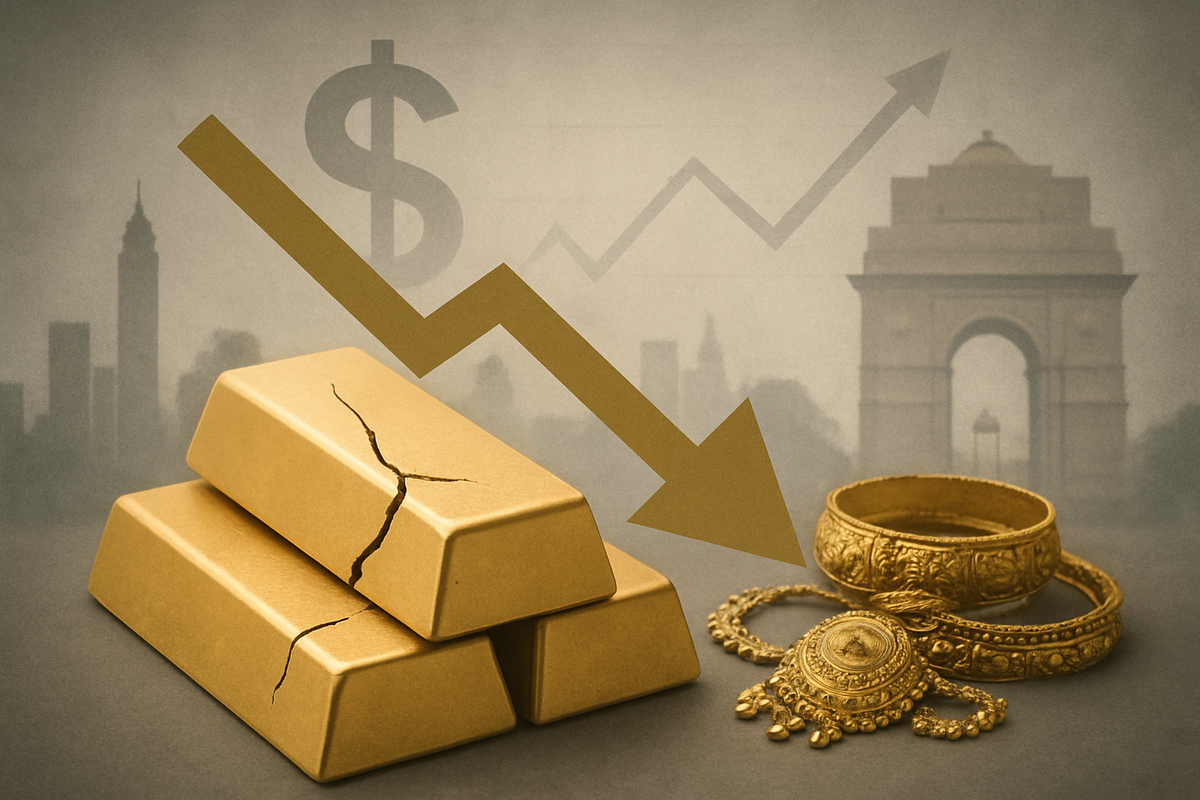
Mumbai, Delhi, and other major Indian cities witnessed a significant daily fall in 24-karat and 22-karat gold prices on November 17, 2025, reflecting a broader retreat in bullion markets. This downturn, primarily driven by hawkish sentiments from US Federal Reserve officials and a strengthening dollar, has immediate implications for investor confidence and physical gold demand in one of the world's largest gold-consuming nations.
The depreciation in gold values across key Indian markets signals a cautious approach among investors and consumers alike. With global economic signals pointing towards potentially higher-for-longer interest rates in the US, the appeal of non-yielding assets like gold diminishes. This trend, coupled with a stronger US dollar, makes gold imports more expensive for Indian buyers, further dampening local purchasing interest and setting a tone of uncertainty for the coming weeks.
Unpacking the Daily Decline: City-Wise Gold Prices on November 17, 2025
On November 17, 2025, major Indian metropolitan areas experienced a notable drop in gold prices. The 24-karat purity gold, often seen as an investment benchmark, and 22-karat gold, popular for jewelry, both saw declines, albeit with varying magnitudes across cities. This widespread fall underscores the interconnectedness of local Indian gold markets with global financial dynamics.
In Mumbai, 24-karat gold was priced at ₹1,25,673 per 10 grams, recording a substantial fall of ₹573 from its previous day's rate. Similarly, 22-karat gold in the financial capital traded at ₹1,15,204 per 10 grams, down by ₹526. Other major cities, while seeing smaller absolute declines, still reflected the bearish sentiment. Delhi saw 24-karat gold at ₹1,21,330 per 10 grams and 22-karat gold at ₹1,15,550 per 10 grams, both experiencing a fall of ₹100. Bengaluru, Hyderabad, and Kolkata all recorded 24-karat gold at ₹1,24,970 per 10 grams and 22-karat gold at ₹1,14,550 per 10 grams, with a consistent daily fall of ₹110 for 24-karat and ₹100 for 22-karat gold. Chennai followed a similar pattern, with 24-karat gold at ₹1,25,890 per 10 grams and 22-karat gold at ₹1,15,400 per 10 grams, also down by ₹110 and ₹100 respectively.
The primary catalysts for this decline stem from international markets. Recent hawkish statements from US Federal Reserve officials have tempered expectations for imminent interest rate cuts, making gold a less attractive investment compared to interest-bearing assets. Concurrently, a strengthening US dollar makes gold more expensive for holders of other currencies, including the Indian Rupee, thereby reducing demand. This global pressure translated directly into the Indian market, further exacerbated by subdued physical demand across Asia, where dealers have reportedly been offering steep discounts to entice buyers. The Multi Commodity Exchange (MCX) also reflected this bearish sentiment, with gold futures for December delivery experiencing a noticeable drop.
Market Players: Winners and Losers from the Gold Dip
The daily fall in gold prices on November 17, 2025, creates a mixed bag of fortunes for various stakeholders in the Indian market, particularly for public companies deeply entrenched in the gold ecosystem. While lower prices might initially seem detrimental, the nuances of the market reveal both potential winners and those facing headwinds.
Jewelry retailers, such as Titan Company (NSE: TITAN), Rajesh Exports (NSE: RAJESHEXPO), and PC Jeweller (NSE: PCJEWELLER), could potentially see a boost in consumer demand in the short to medium term. Historically, price corrections often stimulate physical buying, especially during India's festive and wedding seasons, which typically extend into the new year. Lower gold prices make jewelry more affordable, potentially driving sales volumes and attracting fence-sitting consumers. However, these companies also hold significant gold inventory, and a sustained price decline could lead to inventory revaluation losses, impacting their balance sheets and profitability if not managed effectively through hedging or dynamic procurement strategies.
On the other hand, financial institutions offering gold-backed loans or gold exchange-traded funds (ETFs) might face challenges. A drop in gold prices could lead to a decrease in the value of collateral for gold loans, potentially requiring customers to provide additional security or face higher loan-to-value ratios. For gold ETF providers, sustained price weakness could lead to redemptions, impacting their assets under management. Furthermore, refiners and bullion dealers might experience reduced margins due to inventory value depreciation and slower turnover if market sentiment remains bearish. Overall, companies with robust inventory management, hedging strategies, and diversified revenue streams are better positioned to navigate such market fluctuations.
Broader Implications: A Glimpse into Gold's Wider Significance
The daily dip in Indian gold prices on November 17, 2025, is more than just a momentary blip; it's a symptom of broader global economic trends and holds significant implications for various sectors. India, being one of the largest consumers of gold, acts as a crucial barometer for global gold demand, and local price movements often reflect international shifts.
This event fits squarely into the ongoing narrative of global monetary policy tightening, particularly by the US Federal Reserve. As the Fed continues its hawkish stance, the US dollar strengthens, and bond yields rise, making dollar-denominated assets more attractive than non-yielding gold. This dynamic sets a challenging environment for gold, pushing its prices down worldwide and subsequently impacting import-dependent markets like India. The ripple effects extend beyond the immediate gold market, influencing consumer spending patterns, especially during the crucial festive and wedding seasons. A sustained downtrend could lead to a reallocation of household savings from physical gold to other asset classes, potentially boosting equity markets or fixed-income instruments.
Regulatory and policy implications also come into play. The Indian government, which has historically implemented measures like import duties and gold monetization schemes to manage gold flows and reduce current account deficits, will closely monitor these price movements. Significant or prolonged price volatility could prompt reviews of existing policies or the introduction of new ones aimed at stabilizing the market or influencing domestic demand. Historically, India has seen periods where global economic uncertainties or domestic policy changes have caused similar gold price fluctuations, highlighting gold's role as both a cultural staple and a financial asset that responds to a complex interplay of forces.
What Lies Ahead: Navigating Gold's Future Path
The recent fall in gold prices sets the stage for a period of continued vigilance and strategic adjustments for investors and businesses alike. The short-term trajectory of gold in India will largely be dictated by forthcoming global economic indicators and the pronouncements of central banks, particularly the US Federal Reserve.
In the short term, market volatility is expected to persist. Traders will be keenly watching upcoming US economic data, such as inflation reports and employment figures, for any signs that might alter the Federal Reserve's monetary policy stance. A dovish shift could quickly trigger a rebound in gold prices, while continued hawkishness might lead to further declines. For Indian consumers, these price corrections could present a window of opportunity for fresh buying, especially for those planning weddings or other significant purchases, but many might remain cautious, anticipating further fluctuations. Jewelers and retailers may need to adapt their inventory management and marketing strategies to capitalize on potential demand surges at lower price points or mitigate risks associated with declining inventory values.
Looking further ahead, the long-term outlook for gold will depend on the evolution of global inflation, geopolitical stability, and the overall health of major economies. If inflation remains sticky or geopolitical tensions escalate, gold's traditional role as a safe-haven asset could reassert itself, driving prices higher. Conversely, a prolonged period of global economic stability and higher real interest rates could keep gold under pressure. Strategic pivots for investors might include diversifying portfolios, considering gold as a long-term hedge against uncertainty rather than a short-term speculative play. Market opportunities could emerge for those with a long-term perspective to accumulate gold at relatively lower levels, while challenges will persist for those exposed to short-term price fluctuations without adequate hedging.
Wrap-up: Assessing Gold's Enduring Significance
The daily fall in 24-karat and 22-karat gold prices across major Indian cities on November 17, 2025, serves as a potent reminder of gold's susceptibility to global macroeconomic forces. The immediate triggers – hawkish US Fed remarks and a stronger dollar – underscore how international monetary policy directly impacts local Indian markets, influencing everything from investor sentiment to consumer purchasing decisions.
Moving forward, the gold market is poised for continued dynamism. While the recent price correction may offer tempting entry points for some, the prevailing sentiment suggests caution due to ongoing global uncertainties. Key takeaways include the significant impact of US interest rate expectations on gold's appeal, the importance of the US dollar's strength, and the subdued nature of physical demand despite lower prices. The market is not merely reacting to current events but is actively anticipating future policy directions, making it a highly sensitive environment.
Investors should closely monitor upcoming US economic data, particularly non-farm payrolls and inflation reports, as these will heavily influence the Federal Reserve's future actions. Additionally, tracking the Rupee-dollar exchange rate will be crucial, as a weaker Rupee can offset global price declines for Indian buyers. The lasting impact of this event will likely be a reinforcement of gold's role as a complex asset, influenced by a myriad of factors, and a testament to the need for informed, strategic decision-making in navigating its volatile yet enduring appeal.
This content is intended for informational purposes only and is not financial advice




